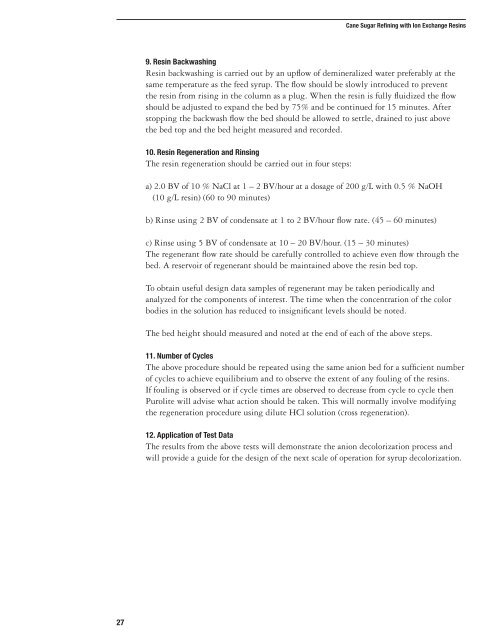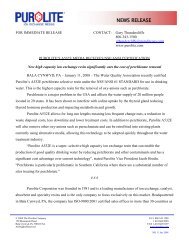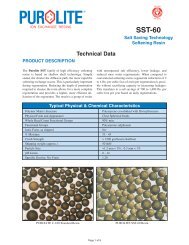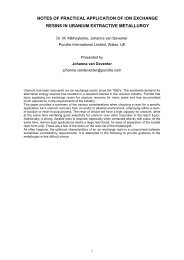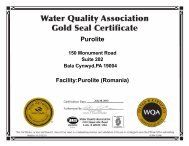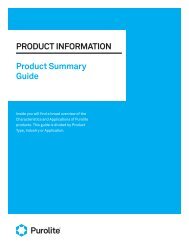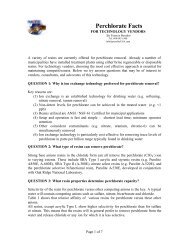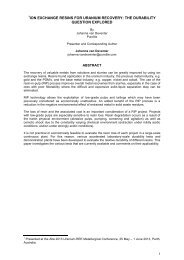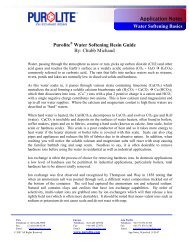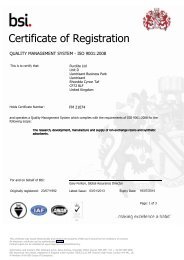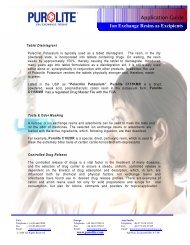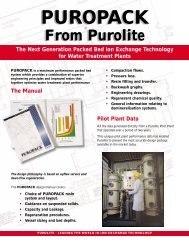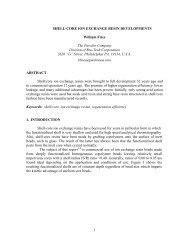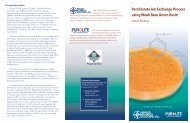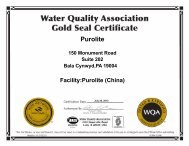Cane Sugar Refining - Purolite
Cane Sugar Refining - Purolite
Cane Sugar Refining - Purolite
Create successful ePaper yourself
Turn your PDF publications into a flip-book with our unique Google optimized e-Paper software.
27<br />
<strong>Cane</strong> <strong>Sugar</strong> <strong>Refining</strong> with Ion Exchange Resins<br />
9. Resin Backwashing<br />
Resin backwashing is carried out by an upflow of demineralized water preferably at the<br />
same temperature as the feed syrup. The flow should be slowly introduced to prevent<br />
the resin from rising in the column as a plug. When the resin is fully fluidized the flow<br />
should be adjusted to expand the bed by 75% and be continued for 15 minutes. After<br />
stopping the backwash flow the bed should be allowed to settle, drained to just above<br />
the bed top and the bed height measured and recorded.<br />
10. Resin Regeneration and Rinsing<br />
The resin regeneration should be carried out in four steps:<br />
a) 2.0 BV of 10 % NaCl at 1 – 2 BV/hour at a dosage of 200 g/L with 0.5 % NaOH<br />
(10 g/L resin) (60 to 90 minutes)<br />
b) Rinse using 2 BV of condensate at 1 to 2 BV/hour flow rate. (45 – 60 minutes)<br />
c) Rinse using 5 BV of condensate at 10 – 20 BV/hour. (15 – 30 minutes)<br />
The regenerant flow rate should be carefully controlled to achieve even flow through the<br />
bed. A reservoir of regenerant should be maintained above the resin bed top.<br />
To obtain useful design data samples of regenerant may be taken periodically and<br />
analyzed for the components of interest. The time when the concentration of the color<br />
bodies in the solution has reduced to insignificant levels should be noted.<br />
The bed height should measured and noted at the end of each of the above steps.<br />
11. Number of Cycles<br />
The above procedure should be repeated using the same anion bed for a sufficient number<br />
of cycles to achieve equilibrium and to observe the extent of any fouling of the resins.<br />
If fouling is observed or if cycle times are observed to decrease from cycle to cycle then<br />
<strong>Purolite</strong> will advise what action should be taken. This will normally involve modifying<br />
the regeneration procedure using dilute HCl solution (cross regeneration).<br />
12. Application of Test Data<br />
The results from the above tests will demonstrate the anion decolorization process and<br />
will provide a guide for the design of the next scale of operation for syrup decolorization.


